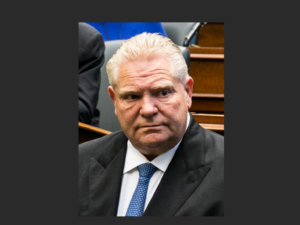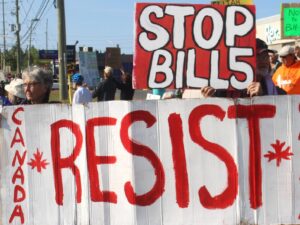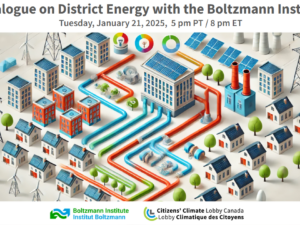 |
MEDIA PACKET, JAN. 27, 2015Media Contact: Cathy Orlando, National Manager cathy@citizensclimatelobby.ca 705-929-4043 |
Ontario can be a climate leader with an effective price on carbonAs the province considers its carbon pricing options, a growing number of experts and pundits are calling for a revenue neutral carbon tax. The government of Ontario will soon announce its carbon pricing policy, and that’s prompted economists, environmentalists and newspapers to weigh in with their preference for Canada’s largest province. With a choice between a BC-styled carbon tax and a cap and trade model similar to Quebec, experts and pundits are leaning towards the former. In recent editorials, the Globe and Mail and Toronto Star have urged Ontario to look to B.C. for its carbon pricing model. Even the National Post concedes that a carbon tax would be the most efficient way to reduce greenhouse gas emissions. Economists and political pundits from either side of the political spectrum have also announced their preference for a revenue neutral carbon tax, including Preston Manning, a member of the new Canadian Ecofiscal Commission, Dr. David Robinson, Director of Director of the Institute for Northern Ontario Research and Development and Green Party candidate, and Jeff Rubin, economist and author. Recently, Nicholas Rivers, Chairholder, Canada Research Chair in Climate and Energy Policy, released a paper called The case for a carbon tax in Canada, outlining how carbon taxes are effective, efficient, easy to design and transparent, and even popular with the public. Citizens’ Climate Lobby (CCL), which urges the federal governments in Canada and the United States to legislate a revenue neutral carbon tax similar to the BC model, recognizes that Ontario’s decision will have a strong impact on the direction the next federal government will take on this issue. CCL volunteers in Ontario are meeting with Ministers and their MPPs, urging them to consider the carbon pricing mechanism called Carbon Fee and Dividend. Carbon Fee and DividendCarbon Fee and Dividend places a steadily-rising fee on the carbon dioxide content of fossil fuels at the well, mine or port of entry. The fee increases steadily each year with the intention of making clean energy cheaper than fossil fuels within a decade. The revenue from that fee is returned to households in equal shares in the form of a dividend cheque. Under this plan 66% percent of Canadian households would break even or receive more in their dividend cheque than they would pay for the increased cost of energy, thereby protecting the poor and middle class from the impacts of the rising fee. A predictably increasing carbon price will send a clear market signal which will unleash investments in the new clean-energy economy. A study from Regional Economic Models, Inc. (REMI) – released last summer by CCL – looked at the impact of a fee starting at $10 per tonne of CO2 that rose $10 per tonne each year in the United States. In the study, all the revenue from the fee was divided equally among all households and returned as monthly payments. After 20 years, CO2 emissions were cut in half and 2.8 million jobs were added to the American economy. The job growth comes primarily from the stimulus effect of recycling carbon fee revenue into the pockets of people who are likely to spend the money. Carbon Fee and Dividend in OntarioThe largest source of greenhouse gas emissions in Ontario is from transportation. According to the Environment Commissioner of Ontario’s 2014 report, Looking for Leadership: the costs of climate inaction: “The largest reductions since 1990 have been in the electricity and industry sectors. The electricity sector alone has seen a 43 per cent reduction in emissions over this time period, with the industrial sector contributing a further 21 per cent reduction. Partially offsetting these reductions, however, has been the 24 per cent increase in emissions from the transportation sector since 1990. The transportation sector remains the largest contributor to the overall provincial inventory, despite a 5 per cent dip in emissions from 2011 to 2012.” Any credible carbon pricing policy in Ontario must impact all sectors that use these fossil fuels, including transportation. A cap and trade policy aimed solely at industry will help reduce emissions in that sector, but could prompt a reduction on retail fuel price, incentivizing drivers to consume more. “A rising fee on carbon at the point it enters the Ontario market will be fair to all sectors in the province, and an efficient means to reduce overall greenhouse gas emissions while stimulating the province’s burgeoning clean technology sector,” says Cathy Orlando, CCL Canada’s National Manager. Ontario’s Clean Technology RevolutionAccording to Ottawa-based think tank, Analytica Advisors, Ontario’s clean technology sector is on the rise. In its 2014 Canadian Clean Technology Report, Analytica Advisors found that 35 percent of clean technology companies are located in Ontario, up from 31 percent the year before. This sector has tremendous potential, and Ontario, with its historical manufacturing base, can lead the way. According to Analytica Advisors, Canada’s clean technology sector, currently an $11.3 billion industry, has the potential to grow to $50 billion by 2022 and represent two percent of the global market share. Clean technology could transform Canadian industrial practices if the Canadian and provincial governments legislates policies that optimize its growth. Other countries have taken notice, buying environmentally-friendly Canadian technologies that help reduce and recycle solid waste, improve efficiencies and reduce our reliance on fossil fuel and petro-products. Approximately 74 percent of Canadian clean technology companies are exporters, with 42 percent of export sales going to non-US countries. Without domestic support, Canadian clean technology companies are in danger of being bought out by international players, taking Canadian innovation and jobs with them. While Canadian clean technology enjoys strong market diversification overseas, it struggles to compete domestically. One challenge is the price of carbon-based energy, which is relatively cheap in Canada compared to many countries. A fee on carbon that rises annually will send a market signal to invest in technologies that help reduce carbon emissions and clean up the environment. Ontario need look no further than British Columbia for a made-in-Canada solution to pricing carbon. Between 2008, when BC legislated a revenue neutral carbon tax, and 2010, the province’s clean technology sector’s sales grew by 48 percent. In 2012, BC was home to 22 percent of clean technology companies in Canada. Supporting Ontario’s Agriculture SectorAgriculture plays an important role in Ontario’s economy and offers potential climate-friendly solutions. Through effective land restoration practices that improve soil productivity, Ontario’s agriculture sector could play a major role in sequestering CO2. Agriculture in Ontario accounts for 9.4 percent of the province’s greenhouse gas emissions. A rising fee on fossil fuels as they enter the provincial market will send a price signal to farmers to adopt practices and innovations that reduce their reliance on fossil fuels. In a 2014 study on the effect of BC’s carbon tax on the province’s agriculture sector, the authors found “little evidence that the carbon tax was associated with any statistically significant effects on agricultural trade or competitiveness from 2008-2011, despite the sector being singled out as ‘at risk’ by the provincial government.” Carbon Fee and Dividend will benefit farmers in a number of ways. The rising fee will increase the incentive to lower their greenhouse gas emissions, and lease land for wind turbines. Solar farms can also replace cropland that doesn’t generate enough income from traditional farming. Farmers will also receive dividend cheques that they can use to help pay for these innovations. Public SupportWhile Stephane Dion’s failed Carbon Shift is often cited as a reason for politicians to avoid carbon taxes, the temperature is changing regarding public acceptance. BC’s former premier, Gordon Campbell was re-elected following the introduction of the province’s carbon tax, which has enjoyed strong support from British Columbians according to polls. The most recent poll, from Abacus Data, shows that 69 percent of Canadians feel that Canada should introduce a policy that provides a financial incentive to reduce carbon emissions over time. Fifty-nine percent would like to see increased taxes on activities and products that produce higher emissions, while 78 percent support lower taxes on activities and products that produce lower emissions. Carbon Fee and Dividend offers Ontario a solution that supports and will foster public acceptance of a carbon tax through the rising fee on fossil fuels and money returned to households through dividend cheques. Ontario will also benefit from a growing clean technology sector that offers high quality jobs, stimulated by the rising fee on fossil fuels. About Citizens’ Climate LobbyCitizens’ Climate Lobby (CCL) is a growing organization of more than 250 local volunteer chapters in Canada, the U.S., and worldwide that are pressing for progressive climate legislation. Currently, CCL citizen volunteers lobby representatives to support the carbon pricing mechanism, Carbon Fee and Dividend, and to end subsidies to fossil fuel companies. The former puts a direct fee on carbon-based fuels at the source, providing a market signal to invest in clean energy technology, while returning the fee’s revenue to citizens in the form of regular payments. CCL was founded in 2007 in the U.S. by Marshall Saunders, a recipient of the Grameen Foundation Humanitarian Award. |













